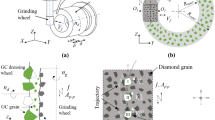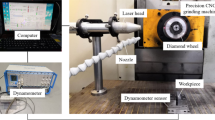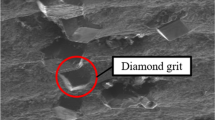Abstract
Laser-assisted ultrasonic dressing (LUD) of the removal behavior of diamond wheel material is investigated by simulation and experimental method. The finite element model of diamond wheel is constructed for simulation during LUD. The effect of parameters of LUD process on the dressing force is discussed according to the simulation results. LUD experiments of diamond wheels are carried out after obtaining optimization of parameter. The dressing force obtained from simulation and experiments are compared. It is found that the variation tendency of simulated dressing force is in agreement with the experimental result. This indicates that the simulation results can be effectively used for the selection of process’ parameters.










Similar content being viewed by others
Abbreviations
- LUD:
-
Laser-assisted ultrasonic dressing
References
Cui, Z. M., He, Q. S., Feng, C. J., & Wang, X. (2016). Study on dressing technology of super abrasive products. Diamond & Abrasives Engineering,36(1), 43–49.
Ding, W., Linke, B., Zhu, Y., Li, Z., Fu, Y., & Su, H. (2017). Review on monolayer CBN superabrasive wheels for grinding metallic materials. Chinese Journal of Aeronautics,30(1), 109–134.
Chen, B., Li, S., Deng, Z., Guo, B., & Zhao, Q. (2017). Grinding marks on ultra-precision grinding spherical and aspheric surfaces. International Journal of Precision Engineering and Manufacturing-Green Technology,4(4), 419–429.
Lu, Y. J., Xie, J., & Si, X. H. (2015). Study on micro-topographical removals of diamond grain and metal bond in dry electro-contact discharge dressing of coarse diamond grinding wheel. International Journal of Machine Tools and Manufacture,88, 118–130.
Chen, G., Deng, H., Zhou, X., Zhou, C., He, J., & Cai, S. (2015). Online tangential laser profiling of coarse-grained bronze-bonded diamond wheels. The International Journal of Advanced Manufacturing Technology,79, 1477–1482.
Chen, G. Y., Chen, C., Chun, B. U., & Jia, T. Y. (2012). Numerical simulation and experiment for on-line truing and dressing of bronze-bonded diamond grinding wheels with laser. Laser Technology,36(4), 433–437.
Wang, Y., & Wang, S. M. (2008). Study on fiber laser assisted truing and dressing of diamond wheel in-process. Advanced Materials Research,53–54, 255–258.
Lee, C. M., Kim, D. H., Baek, J. T., & Kim, E. J. (2016). Laser assisted milling device: A review. International Journal of Precision Engineering and Manufacturing-Green Technology,3(2), 199–208.
Zhang, C., & Shin, Y. C. (2002). A novel laser-assisted truing and dressing technique for vitrified CBN wheels. International Journal of Machine Tools and Manufacture,42(7), 825–835.
Tian, Y., & Shin, Y. C. (2007). Thermal modeling and experimental evaluation of laser-assisted dressing of superabrasive grinding wheels. Proceedings of the Institution of Mechanical Engineers Part B-Journal of Engineering Manufacture,221(4), 605–616.
Lee, S. J., Kim, J. D., & Suh, J. (2014). Microstructural variations and machining characteristics of silicon nitride ceramics from increasing the temperature in laser assisted machining. International Journal of Precision Engineering and Manufacturing,15(7), 1269–1274.
Wang, S. (2003). Researches on thermal stability of diamond and thermal damages of its tools. Dalian: Dalian University of Technology.
China Society of Mechanical Engineering. (2006). China materials engineering ceremony. Non-ferrous metal materials engineering (Vol. 4). Beijing: Chemical Industry Press.
Cai, L. R., Jia, Y., & Hu, D. J. (2009). Dressing of metal-bonded superabrasive grinding wheels by means of mist-jetting electrical discharge technology. Journal of Materials Processing Technology,209(2), 779–784.
Johnson, G. R., & Cook, W. H. (1985). Fracture characteristics of three metals subjected to various strains, strain rates, temperatures and pressures. Engineering Fracture Mechanics,21(1), 31–48.
Chen, G., Li, J., He, Y., & Ren, C. (2014). A new approach to the determination of plastic flow stress and failure initiation strain for aluminum alloys cutting process. Computational Materials Science,95(95), 568–578.
Jung, J. W., Choi, J. Y., & Lee, C. M. (2013). A study on laser assisted machining using a laser area analysis method. International Journal of Precision Engineering and Manufacturing,14(2), 329–332.
Zhou, L., Wang, Y., Ma, Z. Y., & Yu, X. L. (2014). Finite element and experimental studies of the formation mechanism of edge defects during machining of SiCp/Al composites. International Journal of Machine Tools and Manufacture,84(6), 9–16.
Nan, X., Xie, L., & Zhao, W. (2016). On the application of 3D finite element modeling for small-diameter hole drilling of AISI 1045 steel. The International Journal of Advanced Manufacturing Technology,84(9-12), 1927–1939.
Xu, S. L. (2011). Study on performance assessment and preparation process of bronze-bonded diamond grinding wheel matrix. Wuhan: China University of Geosciences.
Zhong-Tao, F. U., Yang, W. Y., Zeng, S. Q., Guo, B. P., & Shu-Bing, H. (2016). Identification of constitutive model parameters for nickel aluminum bronze in machining. Transactions of Nonferrous Metals Society of China,26(4), 1105–1111.
Gupta, N., Ahirrao, S. B., Paul, S., & Singh, R. K. (2015). Modeling of micro-scale fiber laser hardening process and optimization via statistical approximation of the engineering models. International Journal of Precision Engineering and Manufacturing,16(11), 2281–2287.
Acknowledgements
This research was supported by the financial supports from the National Natural Science Funds of China (U1204517), Natural Science Fund by the Education Department of Henan Province People’s Republic of China (12B460011), the Doctoral Fund of Ministry of Education of Henan, and the Doctoral Fund of Ministry of Education of China.
Author information
Authors and Affiliations
Corresponding author
Additional information
Publisher's Note
Springer Nature remains neutral with regard to jurisdictional claims in published maps and institutional affiliations.
Rights and permissions
About this article
Cite this article
Yang, Z., Zhang, S., Hu, J. et al. Study of Material Removal Behavior During Laser-Assisted Ultrasonic Dressing of Diamond Wheel. Int. J. of Precis. Eng. and Manuf.-Green Tech. 7, 173–184 (2020). https://doi.org/10.1007/s40684-019-00049-w
Received:
Revised:
Accepted:
Published:
Issue Date:
DOI: https://doi.org/10.1007/s40684-019-00049-w




